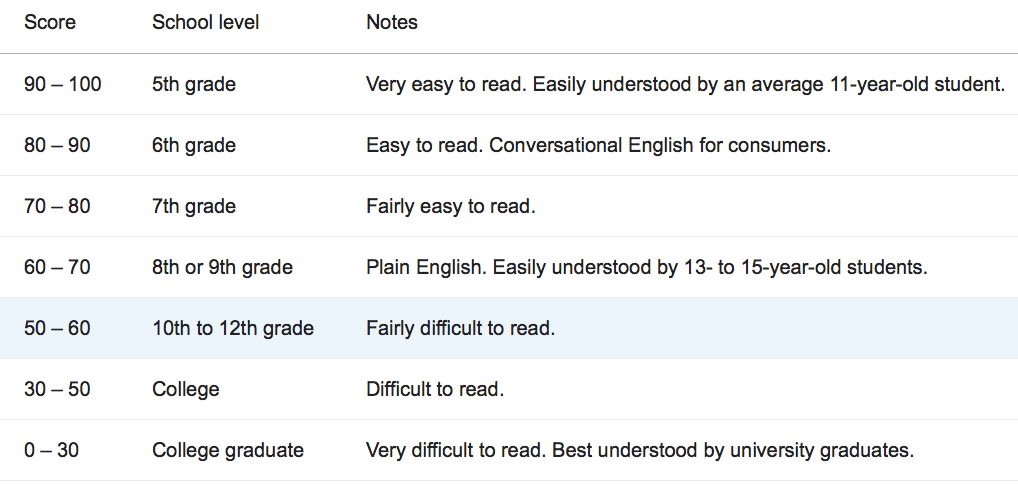The ranking power of readability scores has long been a topic of discussion in SEO communities. While there is much debate on the ranking power of Readability alone, there is no denying search engines aim to provide the best possible search results for their users. Content that is difficult to read can result in a high bounce rate and low engagement, which sends the wrong signal to search engines. In this blog post, I'll provide an overview of what readability scoring is, how it influences SEO, and offer some practical tips to help you improve your readability score.
What is Readability Score?
Readability measures how easy it is to read and understand a piece of content. It considers factors such as sentence length, paragraph length, and word choice. Scores are determined by the Flesch reading ease test, which grades Readability from 1 to 100. The higher the score, the easier the reading level.
Why is Readability Important in SEO?
Regardless of literacy level, online readers generally prefer easy reading, as it is more engaging and enjoyable to read. Content with a low readability score may be more challenging, leading to fewer engagements and high bounce rates.
For this reason, many SEOs focus on generating high value content that is easy to read.
Is Readability a Ranking Factor in SEO?
No. Reading levels are not a ranking factor and it won't fix your SEO. If it's not a ranking factor, then why are readability scores measured on SEO tools, and why do SEOs focus on it?
Search Engine Journal quotes Google's Webmaster Hangout, John Mueller, to answer this question using a medical site as an example. He points out that a medical information website using complex language with long sentence structures may be technically correct.
"But it's not a matter of Google using that reading level score and saying, this is good or bad. But rather, does it match what the people are searching for? And, if nobody's searching for those long words, then nobody's going to find your content. Or, if they do find your content, they're going to be like… I don't know what this means."
Essentially, Readability is not a ranking factor, but it does play a role in SEO in several ways:
- Targets the right keywords
- It keeps users on the page longer
- Improves engagement rate
- Decreases bounce rate
- Communicates your message effectively and clearly
How Do You Determine Readability Level?
Search for your target keyword on Google, then analyze the readability scores of the top 10 results. What is the average readability score? The number you get should be what you aim for. As a general rule, I aim for a readability score of 60 with a minimum of 58.
How Do I Improve My Readability Score SEO?
Now that you have a good understanding of Readability and you know what reading level to aim for, let's dive into how to improve your content readability.
Opt for Short Sentences and Paragraphs
Long and complex sentences can make your content difficult to read. Keep your sentences short and concise, and break down large paragraphs into smaller ones. Ideally, a paragraph should be 3-4 lines.
Use Simple Language
Avoid using jargon or technical terms that your audience may not understand. Use simple and clear language that can be easily understood.
Organize Your Content with Headings and Subheadings
Headings and subheadings can help organize your content and make it easier to read. HTML headings are the H1, H2, and H3 tags used to organize web content.
Not only will good headings improve Readability, but it also helps with your on-page SEO.
Each page should have only one Heading 1 tag (H1).
Then use H2 tags to break up content and H3 tags as subcategories. Typically, you won't need to use H4-H6 tags, but they are there if necessary.
Break up Complex Information With Lists
Bullet points and numbered lists can help break down complex information into easily digestible chunks. Use them to highlight key points or to summarize information.
Use Transition Words
Transition words like "however," "in addition," and "furthermore" can help connect your ideas and make your content flow more smoothly.
Incorporate Multimedia
Visual content can break up long blocks of text and make your content more engaging. Use relevant images and videos to support your content.
Edit and Proofread your Content
Finally, always edit and proofread your content before publishing it. Check for spelling and grammar errors, and make sure your content is clear and easy to understand.
What Readability Tools to Use
There are several tools available for measuring reading level, such as Grammarly, Hemingway Editor, Yoast SEO, and Google Docs, to name a few. Here are some of the tools that I have used and recommend:
- Grammarly: Grammarly can analyze your text for Readability, including sentence length, word choice, and grammar errors.
- Readable: Readable provides a range of readability metrics. It pinpoints sentences and words and offers recommendations to improve Readability.
- SEMRush's SEO Writing Assistant (SWA): SWA is a powerful tool for improving the quality and visibility of your content. It helps improve Readability and optimize content for SEO.
Wrap Up
Employing these tips will help improve engagements and decrease bounce rates. Make a great impression on users who land on your website by creating readable content they will remember.







